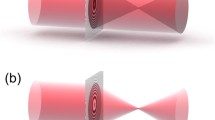Abstract
A new way for generating Bessel beams at mm and sub mm-wavelengths is presented in this paper, in which diffractive optical elements (DOE’s) are designed for converting incident Gaussian beams into Bessel beams. In order to reduce the computational burden and therefore improve the design efficiency, two measures are adopted in our design. One is a body-of-revolution finite-difference time-domain (BOR-FDTD) method that uses a two-dimensional (2-D) solution space instead of a full 3-D space and thereby saves tremendous computational resources, and that is utilized to calculate the fields diffracted by the DOE’s. The other is a microgenetic algorithm (MGA) that has been proved to be more effective than the conventional GA, and that is employed for accelerative optimization. The utility of the present design tool, which combines a MGA with a BOR-FDTD method, is demonstrated by three examples. Numerical simulation results indicate that the designed DOE’s can not only flexibly generate zero- or higher- order Bessel beams when compared with axicons, but also have higher diffraction efficiencies when compared with amplitude holograms.






Similar content being viewed by others
References
J. Durnin, “Exact solutions for nondiffracting beams, I. The scalar theory,”. Journal of the Optical Society of America A 4(4), 651–654 (1987).
J. Arlt, and K. Dholakia, “Generation of high-order Bessel beams by use of an axicon,”. Optics Communication 177, 297–301 (2000).
R. P. MacDonald, S. A. Boothroyd, T. Okamoto et al., “Interboard optical data distribution by Bessel beam shadowing,”. Optics Communication 122, 169–177 (1996).
Z. Bouchal, J. Wagner, and M. Chlup, “Self-reconstruction of a distorted nondiffracting beam,”. Optics Communications 151, 207–211 (1998).
K. Wang, L. Zeng, and Ch. Yin, “Influence of the incident wave-front on intensity distribution of the nondiffracting beam used in large-scale measurement,”. Optics Communications 216, 99–103 (2003).
S. Monk, J. Arlt, D. A. Robertson et al., “The generation of Bessel beams at millimetre-wave frequencies by use of an axicon,”. Optics Communication 170, 213–215 (1999).
R. J. Mahon, W. Lanigan, J. A. Murphy et al., “Novel techniques for millimeter wave imaging systems operating at 100 GHz,”. Proceedings of SPIE, the International Society for Optical Engineering 5789, 93–100 (2005).
W. X. Cong, N. X. Chen, and B. Y. Gu, “Generation of nondiffracting beams by diffractive phase elements,”. Journal of the Optical Society of America A 15(9), 2362–2364 (1998).
G. Y. Zhou, X. C. Yuan, P. Dowd et al., “Diffractive optical elements designed by hybrid algorithm for the generation of nondiffraction beams,”. Proceedings of SPIE, the International Society for Optical Engineering 4291, 148–156 (2001).
J. Salo, J. Meltaus, E. Noponen et al., “Millimeter-wave Bessel beams using computer holograms,”. Electronics Letters 37(13), 834–835 (2001).
J. Salo, J. Meltaus, E. Noponen et al., “Holograms for shaping radio-wave fields,”. Journal of Optics A, Pure and Applied Optics 4(5), S161–S167 (2002).
J. Meltaus, J. Salo, E. Noponen et al., “Radio-wave beam shaping using holograms,” IEEE MTT-S Int. Microw. Symp. Dig., Seattle, WA, 1305–1308 (2002).
J. Meltaus, J. Salo, E. Noponen et al., “Millimeter-wave beam shaping using holograms,”. IEEE Transactions on Microwave Theory and Techniques 51(4), 1274–1279 (2003).
J.-y. Lu, and J. F. Greenleaf, “Nondiffracting X waves–Exact solutions to free-space scalar wave equation and their finite aperture realizations,”. IEEE Transactions on UFFC 39(1), 19–31 (1992).
J. Salo, J. Fagerholm, A. T. Friberg et al., “Unified description of nondiffracting X and Y waves,”. Physical Review E 62(3B), 4261–4275 (2000).
Y. Z. Yu, and W. B. Dou, “Generation of Bessel beams at mm- and sub mm-wavelengths by binary optical elements,”. International Journal of Infrared Millimeter Waves 29(7), 693–703 (2008).
S. Chakravarty, R. Mittra, and N. R. Williams, “On the application of the microgenetic algorithm to the design of broad-band microwave absorbers comprising frequency-selective surfaces embedded in multilayered dielectric media,”. IEEE Transactions on Microwave Theory and Techniques 49(6), 1050–1059 (2001).
S. Shi, and D. W. Prather, “Electromagnetic analysis of axially symmetric diffractive optical elements illuminated by oblique incident plane waves,”. Journal of the Optical Society of America A 18(11), 2901–2907 (2001).
D. W. Prather, and S. Shi, “Formulation and application of the finite-difference time-domain method for the analysis of axially symmetric diffractive optical elements,”. Journal of the Optical Society of America A 16(5), 1131–1142 (1999).
G. Zhou, Y. Chen, Z. Wang, and H. Song, “Genetic local search algorithm for optimization design of diffractive optical elements,”. Applied Optics 38(20), 4281–4290 (1999).
K. Krishnakumar, “Micro-genetic algorithms for stationary and non-stationary function optimization,”. Proceedings of SPIE, the International Society for Optical Engineering 1196, 289–296 (1989).
D. Goldberg, Genetic algorithms in search, optimization, and machine learning. (Addison-Wesley, Reading, Mass., 1988).
A. Taflove, and S. C. Hagness, Computational Electrodynamics: the Finite-Difference Time-Domain Method. (Artech House, Boston,Mass., 2000).
D. Feng, Y. B. Yan, G. F. Jin et al., “Rigorous electromagnetic design of finite-aperture diffractive optical elements by use of an iterative optimization algorithm,”. Journal of the Optical Society of America A 20(9), 1739–1745 (2003).
J. Jiang, and G. P. Nordin, “A rigorous unidirectional method for designing finite aperture diffractive optical elements,”. Optics Express 7(6), 238–242 (2000).
E. G. Johnson, and M. A. G. Abushagur, “Microgenetic-algorithm optimization methods applied to dielectric gratings,”. Journal of the Optical Society of America A 12(5), 1152–1160 (1995).
Acknowledgements
This work is supported by NSFC under grant 60621002, and the Natural Science Foundation of Fujian Province of China (No.A0610027).
Author information
Authors and Affiliations
Corresponding author
Additional information
An erratum to this article can be found at http://dx.doi.org/10.1007/s10762-009-9497-3
Rights and permissions
About this article
Cite this article
Yu, Y.Z., Dou, W.B. Generation of mm- and Sub mm-wave Bessel Beams Using DOE’s Designed by BOR-FDTD Method and MGA. J Infrared Milli Terahz Waves 30, 172–182 (2009). https://doi.org/10.1007/s10762-008-9434-x
Received:
Accepted:
Published:
Issue Date:
DOI: https://doi.org/10.1007/s10762-008-9434-x




